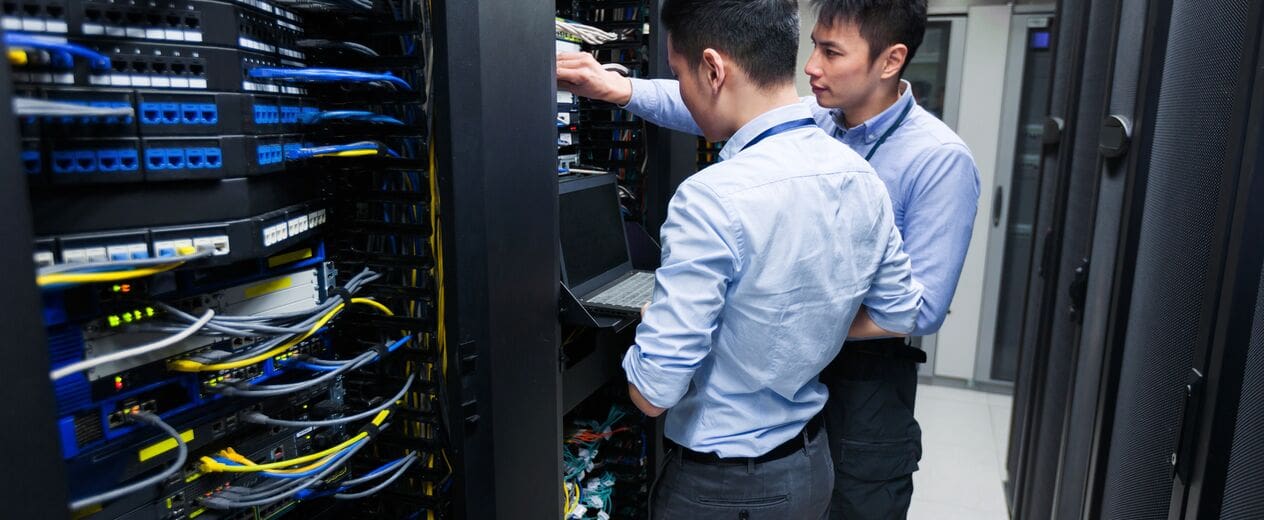Business continuity and data centre: ‘back to back’
By situating your backup data centre adjacent to your business continuity suite, you considerably increase your business resiliency.
Adoption, migration, optimisation, security and management services designed to deliver business agility.
Improve your security posture with tailored strategies and front-line defence services.
Scalable colocation and connectivity within a hyper secure environment.
Disaster recovery and serviced offices in secure, premium office facilities.
Tailored end-to-end solutions for your hardware ecosystem across the widest range of vendors.
Seamless management of your IT environment, underpinned by world-class cyber security, no matter where you are on your journey.
Securely and effectively operate, monitor and maintain your network.
Enjoy the comfort of a modern working space supported by world class technology, security and resilience.
Help your clients take control of their IT environment with Australia and New Zealand’s leading hardware maintenance provider.
Interactive Anywhere provides robust infrastructure solutions designed to support the seamless operation of digital environments. These solutions include scalable cloud services, reliable data storage, and efficient server management, ensuring optimal performance and uptime.
The network solutions from Interactive Anywhere encompass comprehensive design, implementation, and maintenance of secure and efficient networks. By optimising connectivity and bandwidth, these solutions facilitate seamless communication and data transfer, enhancing overall productivity and operational efficiency.
Interactive Anywhere offers dedicated end user support services that ensure users receive prompt assistance with technical issues. This includes help desk support, troubleshooting, and training, aimed at improving user experience and minimising downtime for businesses.
With a focus on safeguarding digital assets, Interactive Anywhere's cyber security solutions provide advanced protection against cyber threats. These solutions include threat detection, risk management, and compliance services, ensuring businesses can operate securely and with confidence.
Interactive offers financial institutions with secure operations, robust cyber security, seamless connectivity, end-user support, and cloud solutions, ensuring long-term resilience.
For manufacturing, precision and efficiency are paramount. Our solutions optimise operations, streamline processes, and ensure seamless connectivity to drive productivity and innovation.
In professional services, reliability and agility are crucial. Our solutions enhance efficiency, streamline workflows, and provide seamless connectivity, empowering firms to deliver exceptional client experiences and stay ahead in a dynamic market.
In aged care, precision and patient well-being are fundamental. Our solutions enhance operational efficiency, streamline workflows, and guarantee secure, seamless connectivity, empowering providers to deliver exceptional care and lead in an ever-evolving sector.
We're Australia's leading IT service provider and we keep technology human.
News & insights from our experts to help you drive performance and grow your business.

Traditionally business continuity suites and data centres have been completely separate entities, which came about because most organisations operate these functions through different parts of the business.
The IT department has typically taken care of the data centre, and the business risk or facilities management team looks after a secondary site for business continuity.
One of the major problems with this approach is that you don’t just have different teams internally looking after these two areas; you also potentially have different external service providers. That adds another level of complexity in a situation when response time and coordination are critical factors in being able to resume operations.
What we’ve been finding is that our customers are looking for a lot more resilience within their business continuity facilities, which can be achieved with a more holistic system that addresses the overall business operations of the organisation – which now fundamentally depend on connectivity and access to critical digital resources and data.
By situating your backup data centre adjacent to your business continuity suite, there are some really significant advantages. Here’s a quick snapshot of just a few:
This trend to combine business continuity and data centre facilities has only been strengthened due to the pandemic. Organisations now are increasingly looking to decentralise. That allows them to limit the risk to their number one critical resource – their people – by operating with physically separate teams. If one team is impacted, the other geographically separate team can operate as normal.
The data centre components in a business continuity facility have typically offered a subset of the resources required by the organisation – those which are absolutely critical to ongoing operations. However, having a permanent arrangement in place with two physically separate teams will work more effectively if you are providing the same level of connectivity and performance to both those teams. This requires a fully redundant, active-active data centre architecture in both primary and secondary sites.
The added complication is in relation to those staff who are working from home. Some of your team will need to operate from your primary or secondary sites due to specialised needs or higher-level security controls, but a proportion of your staff will be able to operate remotely. However, have you fully tested the capabilities of your remote workers to connect to the business en masse via your secondary site?
There’s a lot more to consider with regards to the impact on people, process and technology; but it’s clear that as a result of the pandemic the trend towards combined business continuity and data centre facilities has accelerated, and we are now seeing an emerging demand for something that’s more in line with a high availability serviced office. These trends are likely to only increase as times goes on and making the traditional way of managing data centres, business continuity and even office space a thing of the past.